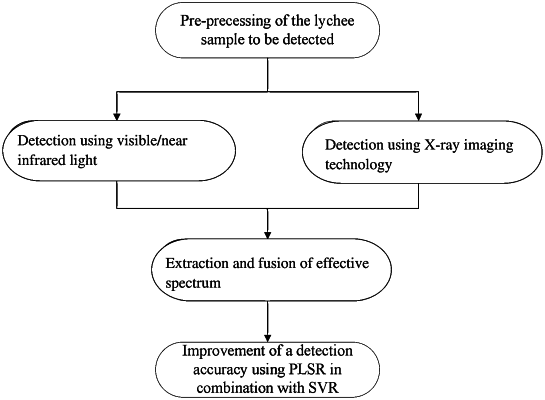| CPC G01N 23/083 (2013.01) [G01N 23/04 (2013.01); G01N 2223/1016 (2013.01)] | 3 Claims |

|
1. A non-destructive detection method for Conopomorpha sinensis Bradley, comprising the following steps:
placing a lychee sample to be detected on a conveyor belt;
acquiring sample information of the lychee sample placed on the conveyor belt based on visible/near-infrared light and X-ray imaging technology; wherein the visible/near-infrared light is used to acquire internal quality features of the lychee sample and the X-ray imaging technology is used to acquire internal density variation features of the lychee sample;
analyzing the sample information according to a preset data processing and analysis method based on PLSR and a support vector machine to obtain a classification result of the lychee sample with and without insects;
the data processing and analysis method based on PLSR and the support vector machine is as follows:
selecting effective wavelengths from full spectrum and fusing the selected effective wavelengths using a continuous projection method;
preliminarily determining a classification of the lychee sample with and without insects using PCA, which is represented by a sample scatter plot formed by a first principle component and a second principal component;
dividing spectral data after feature extraction into a training set and a testing set and establishing a discrimination model using PLSR, wherein a detection result of the lychee sample without insects is set to be 0 and the detection result of the lychee sample with insects is set to 1, a detection effect of a PLSR model is greatly affected by a number of the selected features after dimensional reduction, and the detection result is outputted as a decimal number, which is usually represented by a coefficient of determination R2 between a predicted value and an actual value, as well as a root mean square error;
dividing a training set and a testing set and establishing a prediction model using SVR, wherein a prediction result of the lychee sample without insects is set to be 0 and the prediction result of the lychee sample with insects is set to be 1, and rounding the results of the PLSR model and a SVR model to a nearest integer, wherein when the integer is less than or equal to 0, it indicates the lychee sample does not have insects; when the integer is greater than or equal to 1, it indicates the lychee sample has insects;
the selecting effective wavelengths from full spectrum and fusing the selected effective wavelengths using a continuous projection method comprises:
extracting average grayscale values of a stem, a core, and a flesh in a X-ray transmission image of the lychee sample with the best classification and prediction effect, and combining the average grayscale values with feature bands of the visible/near-infrared transmission spectrum extracted using the continuous projection method to form a comprehensive analysis of multi-source information.
|